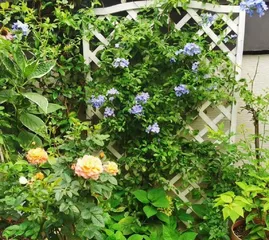I: Understanding the Growing Environment of Blue Snowflake
Blue Snowflake is native to the Himalayan region and thrives in environments with plenty of sunlight and humid air. In winter, it needs to be protected from severe cold, so we must provide appropriate care based on its growing environment.

II: Providing Suitable Temperature for Blue Snowflake
Blue Snowflake needs to grow at a temperature between 5°C and 10°C, so we can place it in a room with a stable indoor temperature. At the same time, pay attention to insulation at night. It's best to avoid placing the Blue Snowflake too close to the window to prevent it from being affected by the cold air transmitted from the window.
III: Ensuring Ample Sunlight for Blue Snowflake
Blue Snowflake needs ample sunlight to grow robustly. Therefore, in winter, we should place it in a sunny spot and ensure it gets at least 6 hours of sunlight daily to help it maintain a healthy growth state.

IV: Paying Attention to Humidity Control for Blue Snowflake
Blue Snowflake is sensitive to humidity, so we should avoid exposing it to environments that are too dry or too humid. In winter, due to indoor heating, the air often becomes drier. At this time, we can protect the Blue Snowflake's growth by increasing indoor humidity.
V: Controlling the Watering Amount for Blue Snowflake
Blue Snowflake needs to maintain a moderately moist environment, but it should not be in a state of being too wet. In winter, due to the drier environment, we can appropriately increase the frequency of watering, but the amount of water each time should not be too much. Also, be sure to ensure good drainage to avoid waterlogging the roots.
VI: Avoiding Moving the Blue Snowflake
Blue Snowflake is a relatively sensitive plant that is easily affected by movement. Therefore, in winter, we should avoid moving it frequently to prevent it from becoming stressed and affecting its growth.

VII: Maintaining Hygiene Around the Blue Snowflake
Blue Snowflake is sensitive to its surrounding environment, so we need to keep the area around it clean, avoid placing clutter, and prevent excessive dust, as this can affect its growth.
VIII: Regularly Fertilizing the Blue Snowflake
In winter, the growth of Blue Snowflake may slow down. At this time, we can enhance its nutrient supply through appropriate fertilization, which can also promote its growth and development.
IX: Avoiding Placing the Blue Snowflake Near Ventilation Outlets
In winter, due to lower temperatures, we often turn on heating to maintain indoor warmth. However, we should avoid placing the Blue Snowflake near ventilation outlets to prevent it from being affected by the direct flow of warm air.
X: Preventing Pest Infestations
In winter, due to the drier environment, Blue Snowflake is susceptible to pests. Therefore, we should regularly check its leaves to prevent pest infestations.
XI: Timely Pruning of the Blue Snowflake
Blue Snowflake grows relatively fast and requires appropriate pruning in winter to maintain its good growth condition and neat appearance.
XII: Moderate Shaping of the Blue Snowflake
While pruning, we can also perform moderate shaping to adjust its structure and branch direction, helping it better adapt to its environment.
XIII: Paying Attention to Pest and Disease Control for Blue Snowflake
In winter, Blue Snowflake is prone to pests and diseases, so we should strengthen pest and disease control measures by promptly removing eggs, fungal spots, and other issues from the leaves.
XIV: Timely Soil Replacement for the Blue Snowflake
Blue Snowflake's growth requires a suitable soil environment, so we need to replace its soil regularly to ensure its growth quality and health.
XV:
Through the detailed introduction of winter care for Blue Snowflake, we can see that while controlling its growing environment, light, and humidity, we must also pay attention to pest and disease control and moderate pruning and shaping. Only in this way can Blue Snowflake grow healthily and robustly during the cold winter.